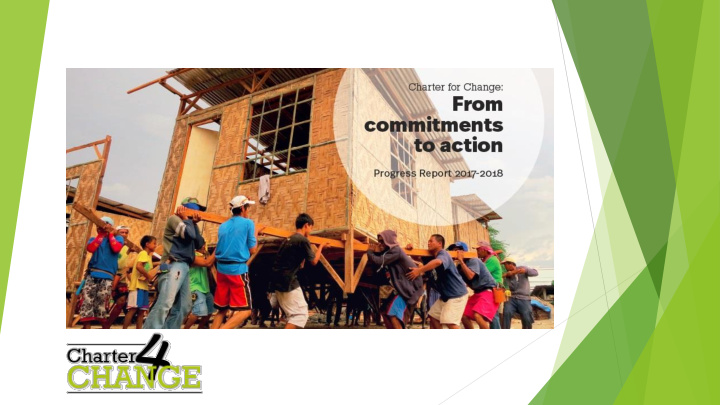



Overall AR17-18 New : self-assessment of progress against commitments, testing C4C against the Rohingya Refugee Response reality C4C: important role as a platform for collaboration and joint advocacy Exercising influence on the global humanitarian policy dialogue In a few countries, C4C emerging as an important platform for local and national dialogue and advocacy (& coordination?); C4C endorsers’ leadership on advocating for GB and C4C in practice) This role was reinforced at the 2017 C4C Annual Meeting in The Hague Continued from 16-17: C4C incorporation in new international strategies, organisational emergency response approaches, communications strategies, new partnership policies, or reporting on C4C commitments to program quality committees and organizations' senior most leadership Discrepancy between awareness/buy-in of commitments between HQs and country program levels Differences in implications: Partnership-focused signatories & signatories w mixed direct-implementation/partnership approaches
More socialisation of C4C with local/partner organisations needed? Ca. doubling of C4C endorsers since April 2017 (234 today)
Overall:
Commitments 2 & 6: Partnership and Equality Partnership / PoP Equality - Signatories to PoPs and/or similar -Business as normal approach → need to avoid complacency principles (network-specific, -Shift in operating model – adjusting organisation specific) A ‘Partners’ internal systems and tools to incorporate Charter’: expect -Verification: external certification stronger partnership approaches transparency on (CHS, 7 orgs) budgets, shared learning, fairness, Challenges: staff behaviour, Challenges: complaints - ‘Either/or’ discussion → different and • Organisational culture handling, etc. contextual ways of working with partners • Discrepancies across teams and regions - fragile contexts and war zones (local orgs’ • Fragile contexts and org capacity vs. the Conducting structures/governance under stress) humanitarian imperative (e.g. Sth Sudan, structural needs -Behaviour change, in the heat of a Mali, Northern Nigeria, DRC) assessments with response • Donor preference for technical partner s ahead of -Better & more resources for strengthening specialisation, operational delivery at scale design stages partners’ systems → Internal strategies, improving consistency → Formalising and mainsteam PoPs in docs of partnership approaches → Raise awareness on PoPs (internally & → Redress imbalances btw. INGO and local with partners) actor capacities
Commitment 4: Stop undermining local capacity diversity in compliance, Least progress made Not an issue (signatories who work entirely through partnerships) Compensation policies highly challenging Not prioritised ethical recruitment policy (4 agencies) strengthening country-specific or regional surge capacity raising awareness among country colleagues inclusion in partner contracts
Commitment 5: Emphasize the importance of local actors 2 nd highest overall compliance More awareness and interest among donors, joint discussions on how to best support local and national actors Bilateral meetings (hq & country levels), collective meetings and influencing Increase in funding to pooled funds Institutionalisation of C4C advocacy to donors still needs attention Challenges: trend: Major donors preferring fewer partners Donor preference for high volume of funds and no’s of beneficiaries Interest in investing in strong/large national NGOs → less focus on capacity strengthening of smaller actors, less diverse field of local and national humanitarian actors → Risk mitigation scenarios, collective provision of practical solutions to donors → More joint planning among humanitarian and development programming
Special report on C4C and the Rohingya crisis refugee response
Recommend
More recommend